
A groundbreaking study conducted by researchers from Toyohashi University of Technology and Caltech introduces a novel understanding of how brain activity can influence group dynamics in real-time. The research dives deep into the concept of “team flow,” a state characterized by heightened focus and synergy among individuals working together towards a common goal. This phenomenon isn’t just anecdotal; it’s a critical element that can determine the success or failure of collaborative efforts across various fields, from corporate environments to creative industries, and even challenging settings like space missions.
The pivotal element of this study is the development of an innovative algorithm that captures individual brain activity in a multi-dimensional space, resulting in a neural “fingerprint.” This fingerprint is a representation of stable, long-term traits inherent to each individual, which are further intertwined with transient brain states experienced during social interactions. By mapping these attributes, researchers aim to shed light on the unique interplay between enduring neural characteristics and fleeting mental states critical for achieving collective focus and harmony.
In a meticulously designed experiment, participants engaged in a rhythm-based, collaborative video game while their brain activity was monitored through EEG (electroencephalogram) data collection. This experimental setup allowed for a detailed analysis of how individuals transitioned between solo and cooperative gameplay modalities. It revealed fascinating insights into the neurological mechanisms that underpin effective teamwork and how cognitive processes adapt to accommodate social dynamics.
The findings were particularly striking: when participants exhibited closely aligned neural fingerprints within this seven-dimensional space, the likelihood of achieving a shared state of deep concentration significantly increased. This correlation holds vital implications for optimizing team performance, suggesting that aligning neural pathways among team members can produce a more cohesive and productive work environment, even under the stress of external distractions.
This enlightening research offers an answer to long-standing questions about how brain synchronization occurs. It posits that individuals with similar neural signatures are more predisposed to work effectively as a unit, highlighting the importance of selecting teams based on compatible cognitive/neurological profiles. It reframes our understanding of collaboration, moving beyond interpersonal skills and towards an intriguing intersection of neuroscience and social psychology.
Moreover, the implications of this study extend far beyond academic curiosity. In practical terms, it opens the door for organizational leaders to devise strategies aimed at enhancing human collaboration by intentionally forming groups whose neural fingerprints align closely. Such approaches could fundamentally transform how teams are constructed in various business sectors, thereby improving creativity, productivity, and overall success rates.
The research also holds promise for applications in high-stakes environments that require seamless teamwork, such as in healthcare, military operations, and even sports. Understanding the brain’s alignments and enhancing team flow could lead to the development of training programs explicitly designed to groom individuals for roles that necessitate high levels of cooperation and joint effort.
Researchers acknowledge that while this study focused on short-term interactions within a controlled environment, the insights gleaned could be applied more broadly. Future studies will be necessary to gauge the long-term applicability of these findings in real-world settings where variables can fluctuate dramatically. This aspect remains a vital consideration as it will help bridge the gap between laboratory findings and practical applications.
Funding for the research was generously provided by several respected institutions, underlining the importance and potential impact of this work in the scientific community. The collaborative nature of the project itself—melding expertise from multiple leading institutions—serves as a testament to the power of interdisciplinary research, further signaling to both academic and corporate worlds the value of collaborative endeavors in unlocking breakthroughs.
As we stand on the cusp of a new understanding of human collaboration filtered through a neurological lens, the issues surrounding teamwork in both everyday and extraordinary contexts take on fresh significance. By revealing the hidden threads that tie together brain activity and social interaction, this study provides a compelling framework for individuals and organizations alike to rethink how they approach collaboration.
With implications for enhancing teamwork and decision-making processes across various environments, researchers assert that this work is not merely a lens into the brain’s workings; it is a pathway toward fostering effective collaboration. In doing so, it heralds a promising new era where science and social needs converge, ultimately enriching our understanding of how individuals can work together harmoniously for shared goals.
The enthusiastic reception this study has garnered within the scientific community underscores the need for continued exploration in this field. As researchers continue to decode the complexities of human interaction and the neurological foundations that support it, we can anticipate further advancements that will unveil even deeper insights into the nature of collaboration.
In conclusion, the intersection of neuroscience and teamwork offers a rich vein of inquiry that promises to yield transformative results in the decades to come. As we harness the knowledge gained from these studies, we create opportunities to build better work environments, enhance productivity, and foster collective success across various domains, paving the way for innovations yet to be imagined.
Subject of Research:
Article Title: A hierarchical trait and state model for decoding dyadic social interactions
News Publication Date: 3-Apr-2025
Web References:
References: Qianying Wu, Shinsuke Shimojo, Mohammad Shehata, and Shigeki Nakauchi (Year). A hierarchical trait and state model for decoding dyadic social interactions. Nature Scientific Reports. doi: 10.1038/s41598-025-95916-9
Image Credits: COPYRIGHT(C)TOYOHASHI UNIVERSITY OF TECHNOLOGY. ALL RIGHTS RESERVED.
Keywords
Social sciences, Scientific research, Scientific collaboration.
Tags: collaborative brain activitycollective focus in team settingsEEG monitoring in group settingsenhancing group performance through neuroscienceimpact of brain states on teamworkinnovative algorithms in neuroscienceneural fingerprints in teamworkreal-time analysis of brain interactionsresearch on teamwork and collaborationsynergy in collaborative environmentsteam flow dynamicstransient and stable neural traits





